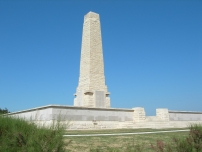| First Name: | Charles Frederick | Last Name: | WEBBER | |
|---|---|---|---|---|
| Date of Death: | 21/08/1915 | Lived/Born In: | Barking | |
| Rank: | Lance Corporal | Unit: | Royal Dublin Fusiliers7 | |
| Memorial Site: | 1. Barking Memorial 2. Helles Memorial, Gallipoli | |||
Current Information:Born-Barking
Gallipoli 1915 On 25 April, British, Australian and New Zealand forces landed on the Gallipoli peninsula. The plan was that these forces would soon defeat a demoralised Turkish army, knock Turkey out of the war, open up the Mediterranean to the Russian navy and threaten Austro-Hungary from the south. None of these things were achieved despite nine months of hard fighting in terrible conditions. It was a heroic failure. By July, 1915, and after much fierce fighting, stalemate had set in at Gallipoli both at Cape Helles where the British and French had landed and at Anzac Cove where the Australian and New Zealand Corps were unable to break out of their beach head. Fresh troops were needed and they were on their way in the shape of four divisions from Britain and things were put on hold until they arrived. The plan for August was for a landing at Suvla Bay to the north of Anzac Cove whilst at the same time, the ANZAC Corps, reinforced by some of the new British troops would effect a breakout from Anzac Cove and establish a line across the peninsula. Whilst this was going on the troops in the south at Helles would stage a number of diversionary attacks. But it all went horribly wrong and much of the reason for this can be explained by inadequate planning and leadership. Nobody seemed to know what they were supposed to be doing and Lieutenant-General Stopford, in charge of the Suvla landings was particularly out of his depth. The landings at Suvla failed to link up with the forces at Anzac and the breakout from there did not happen despite valiant efforts by all concerned. The loss of life on all fronts was again enormous. L.A. Carlyon’s excellent book “Gallipoli” gives a superb yet chilling account of the events. A final effort to break through at Suvla was made on 21st August by 29th Division, which had been brought round from Helles, 11th Division and the recently arrived 2nd Mounted Division when, that afternoon, they attacked the W Hills and Scimitar Hill on the Anfarta Spur, due east of Suvla Bay. At the same time units of the ANZAC Corps attacked Hill 60 just to the south of the Suvla front. The operation failed on all three fronts with heavy casualties inflicted on the divisions taking part. During this operation, 10th Division were in general reserve and that afternoon the 7th Royal Dublin Fusiliers battalion of 30 Brigade, moved forward to positions between Hetman Chair and Kazlar Chair in support of 11th Division. Here they cam under heavy shell fire and suffered a number of casualties one of whom was Charles Webber. |
||||
| « Back to Search Results | ||||
| If you think any of the information shown here is incorrect, Click Here to submit your amends and comments | ||||




